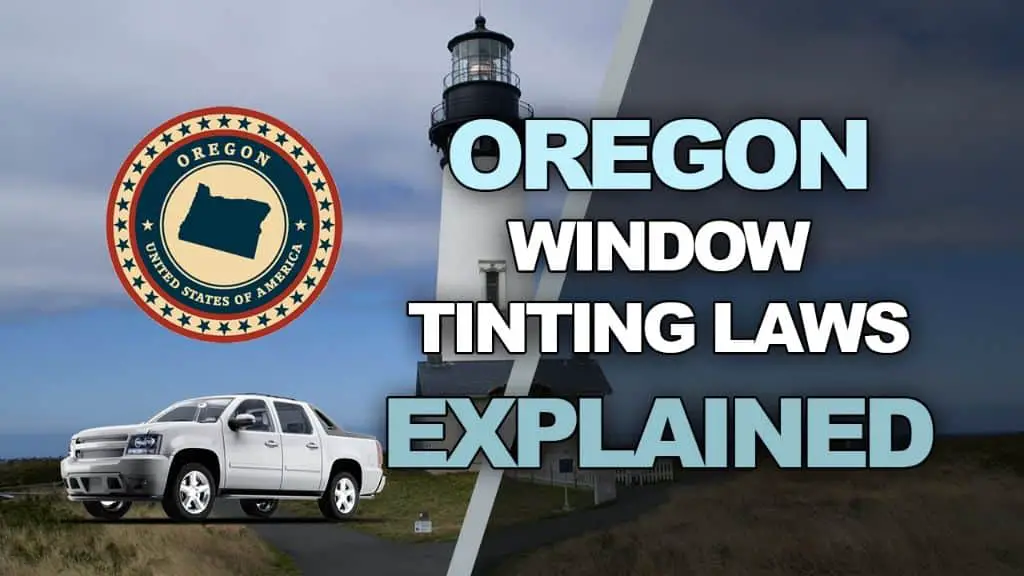

Article Created by Ryan Pietrzak
Last updated on February 14, 2024Oregon Tint Laws – 2024 Updated Legal Tint Limit
Please note that Oregon Tint Laws Regulation can change daily and may be interpreted differently at the city or county level. We recommend verifying this information with your local DMV or law enforcement agencies. We have manually fact-checked this content using official state resources. Oregon enacted tinting laws in 2003. If any information provided is incorrect or outdated, please contact us so we can make the necessary corrections. Thank you.
2024 Oregon Tint Laws – Legal Tint Limit For Passenger Vehicles
- Front Windshield: Non-reflective tint is allowed on the top 6 inches of the windshield.
- Front seat side windows: up to 35% tint darkness allowed
- Back seat side windows: up to 35% tint darkness allowed
- Rear window: up to 35% tint darkness allowed
2024 Oregon Tint Laws – Legal Tint Limit For Multi-Purpose Vehicles
- Front Windshield: Non-reflective tint is allowed on the top 6 inches of the windshield.
- Front seat side windows: up to 35% tint darkness allowed
- Back seat side windows: Any tint darkness can be used
- Rear window: Any tint darkness can be used

- Medical exemptions: Oregon tint laws permit darker tints on front side windows with a doctor’s note
- Oregon tint law prohibits metallic or reflective tint on any of the windows
- Oregon tint law is statewide with no additional local regulations
- Violating Oregon tint laws can be significant. If you are pulled over for window tint that is darker than the legal limit, you could face a fine. The fine for a window tint violation in Oregon is classified as a Class B traffic violation and can amount to $360. This penalty applies for each offense, and it’s important to note that repeated offenses may lead to higher fines
What does VLT Mean according to Oregon Tint Laws?
- Window tint film’s light transmission is measured as VLT (Visible Light Transmission) and each state has its own legal limits for VLT on car windows.
- A HIGHER VLT means that more light is allowed to pass through the window tint film.
- Example: a 75% tint will allow 75% of the light to pass through whereas a 5% tint will only allow 5% of the light to pass through, making the 5% tint a much darker film.
- Oregon window tint laws has specific VLT limits for Passenger Vehicles and Multi-Purpose Vehicles.
FAQ’s Regarding Oregon Tint Laws and Oregon Legal Tint Limit
What is the darkest legal tint in Oregon?
In Oregon, the darkest legal tint for front side windows of a sedan, SUV, or van is 35% VLT (Visible Light Transmission), meaning these windows must allow more than 35% of light in. For the back side windows and rear window of SUVs and vans, any darkness can be used, while sedans must also allow more than 35% of light in for these windows.
Are police exempt from window tint laws in Oregon?
Oregon’s window tint laws do not specifically mention exemptions for law enforcement vehicles. However, it is common for police and other emergency vehicles to have exemptions from certain vehicle equipment regulations, including window tint, for operational reasons.
How do I get a tint waiver in Oregon?
To obtain a window tint waiver in Oregon for medical reasons, you need to acquire a written certification from a licensed medical professional. This certification should state that the darker window tint is necessary due to a medical condition that requires a reduction in exposure to sunlight. Once you have this certification, it typically needs to be submitted to the appropriate state department, such as the Department of Motor Vehicles, for approval and issuance of an exemption.
How much is a tint ticket in Oregon?
In Oregon, the cost of a window tint ticket can be significant. If you are pulled over for window tint that is darker than the legal limit, you could face a fine. The fine for a window tint violation in Oregon is classified as a Class B traffic violation and can amount to $360. This penalty applies for each offense, and it’s important to note that repeated offenses may lead to higher fines. It’s crucial to ensure that your vehicle’s window tint complies with Oregon’s legal limits to avoid these penalties.
Can you get pulled over for tint in Oregon?
Yes, you can get pulled over for having window tint that appears to exceed the legal limits in Oregon. Law enforcement officers in Oregon have the authority to stop vehicles if they suspect the window tint is darker than what is allowed by state law. If your window tint is found to be in violation of the legal limits, you may be issued a citation and fined, so it’s important to ensure your vehicle’s window tint complies with Oregon’s regulations to avoid potential stops and penalties
How to get a Tint Exemption in Oregon
Oregon permits window tint medical waivers. Lower light transmission tint may be installed on the side and rear windows of a vehicle registered in the name of the person, legal guardian, or household member.
An affidavit from a licensed physician or optometrist, a prescription, or a letter on the practitioner’s letterhead must be carried in the vehicle at all times and presented to police officers if asked. This letter or notarized affidavit must state the physical condition that requires darker window tint.
No permits are issued by DMV / Department of Transportation, and the documents above are enough to qualify for exemptions.
The tint installer must also provide you with a certificate stating the total light transmission on windows.
For more information regarding window tint medical exemptions in _____ you can check out this resource:
- Oregon Department of Transportation – Vehicle Equipment Standards (FAQ – Windows)
- Oregon DoT – Frequently asked questions about window tinting (.pdf file)

Ryan Pietrzak
Creator of Windowtintlaws.us
